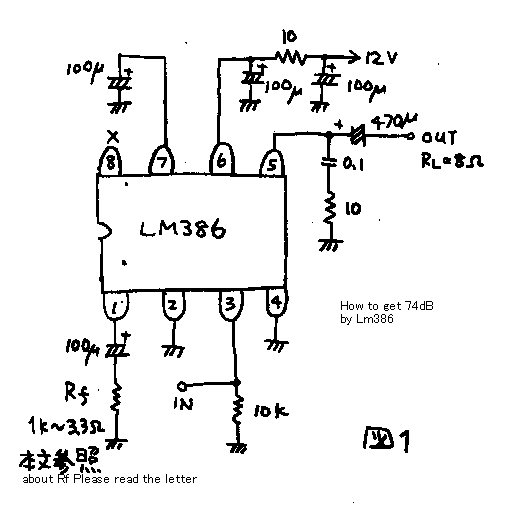7.How to get 74dB by LM386 lm386.gif
 LM386 is very
popular IC also in Japan. It is used in Radio receiver. The power of it
(500mW) is enough for the personal use. But sometimes, the gain of it (40dB)
is not enough. Especially the direct conversion receiver depend on all
of its gain on the audio amplifier. And therefore, we must stay sometimes
the pre-amplifier before LM386. I will show you the way to get the 74dB
only with LM386. Please watch the circuit ! Rf is the feedback control
resister. By chanbeing the Rf you can tune the gain of this circuit as
follows.
LM386 is very
popular IC also in Japan. It is used in Radio receiver. The power of it
(500mW) is enough for the personal use. But sometimes, the gain of it (40dB)
is not enough. Especially the direct conversion receiver depend on all
of its gain on the audio amplifier. And therefore, we must stay sometimes
the pre-amplifier before LM386. I will show you the way to get the 74dB
only with LM386. Please watch the circuit ! Rf is the feedback control
resister. By chanbeing the Rf you can tune the gain of this circuit as
follows.
| Rf (ohm) |
gain |
feedback
resister |
dB |
| 3.3 |
74 |
| 10 |
70 |
| 33 |
54 |
| 105 |
44 |
| 820 |
34 |
--Emailer_-1249716426 Content-Type: text/plain; charset="iso-8859-1"
Content-transfer-encoding: quoted-printable
Dear Sunamura-san, I like to read your web-site very much, and I repeated
some of your constructions. I especially like your LM386 70 dB AF amplifier
which I called =B3the Sunamura amplifier=B2 in our national Ham Magazine.
Now, I have some news for you. The other day I found in our national ham
magazine a new type of a rock stable VFO. They did not mention the first
inventor, but I will try to find out who it was. It is a =8CColumbus= =B9
egg=B9 and it can substitute syntesizers. It uses a CERAMIC RESONATOR,
and the frequency can be spread for about 100 kHz. I attach the electric
diagram. The chief part s are the Ceramic Resonator CR and the variable
capacitor C1. I used a standard CR for 3.579 kHz which is used as a clock
in American digital devices. After a short warm-up, when you turn the capacitor
C1 you can change the frequency for about 150 kHz - from 3440 to 3620 kHz.
To cover the CW segnment of the 80 mteres band a variable capacitor of
140 pf is enough. And the frequency is rock stable. The capacitors C2 and
C3 must have a capacity similar to the own capacity of the CR. In my case
it was 600 pF. I also tried the ceramic filter for 10,7 MHz with three
pins, but then I had to use 50 pF for C2 and C3, because that was the capacity
of the filter. I used only two pins: the middle one and a side one - The
frequency was between 10,9 and 11 MHz and the stability was very good.
I also tried a 5,5 MHz filter, but it did not work well - it gave a frequency
of 17 MHz with only 10 kHz of spread. I am sure that you will make use
of this oscilator - with your tehcnical ingenuity. When I get some new
CRs, I will make some more experiments. Meanwhile, I remain with best wishes,
Bozidar Pasaric, 9A2HL, City of Rijeka, Croatia, Europe My E-mail: bpasaric@mac.com
7.LM386で74dBを得る方法
LM386 は,日本でもとても評判のよいIC です.それは,ラジオ受信機の製作等によく使われています.500mWの出力は,個人用には十分です.しかし、しばしば,その利得
( 40dB )は十分では無い場合があります.特に直接の- 転換- 受信機(ダイレクトコンバージョン)ではオーディオの増幅器にすべてのゲインを依存します.そしてそれゆえに,我々は,LM386
の前に前置増幅器を時々設けなくてはいけなくなります.あなたにLM386で74dB
得る方法を示します.サーキットのRf は,フィード・バック- コントロール- 抵抗です.Rfを換える事によって、全体の利得が上の表の様に調節できます。
back to index
 LM386 is very
popular IC also in Japan. It is used in Radio receiver. The power of it
(500mW) is enough for the personal use. But sometimes, the gain of it (40dB)
is not enough. Especially the direct conversion receiver depend on all
of its gain on the audio amplifier. And therefore, we must stay sometimes
the pre-amplifier before LM386. I will show you the way to get the 74dB
only with LM386. Please watch the circuit ! Rf is the feedback control
resister. By chanbeing the Rf you can tune the gain of this circuit as
follows.
LM386 is very
popular IC also in Japan. It is used in Radio receiver. The power of it
(500mW) is enough for the personal use. But sometimes, the gain of it (40dB)
is not enough. Especially the direct conversion receiver depend on all
of its gain on the audio amplifier. And therefore, we must stay sometimes
the pre-amplifier before LM386. I will show you the way to get the 74dB
only with LM386. Please watch the circuit ! Rf is the feedback control
resister. By chanbeing the Rf you can tune the gain of this circuit as
follows.